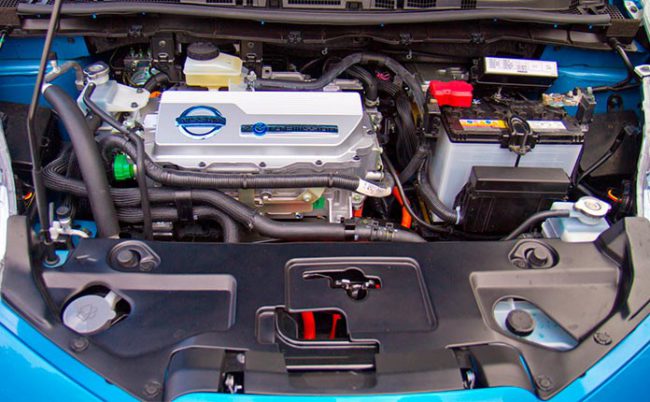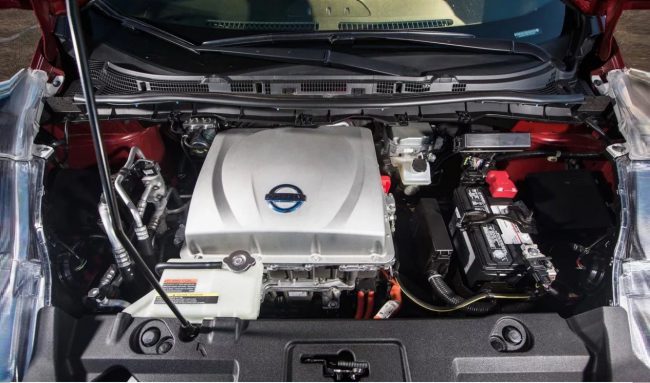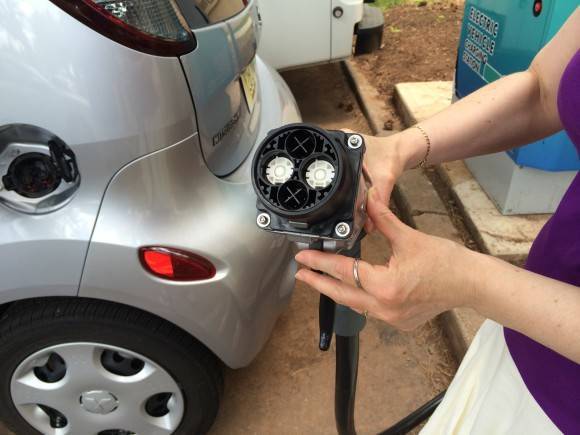
Nissan EM61, EM57 engines
Content
The em61 and em57 engines are used in the cars of the largest automobile company Nissan. Attempts to replace traditional internal combustion engines with electric motor builders of the concern have been trying for a long time. But the real implementation of their developments occurred relatively recently. At the turn of the XNUMXst century, the first electric motor for a car was put into production.
Description
Power units of the new generation em61 and em57 are produced from 2009 to 2017. They come with a single-speed automatic transmission (gearbox), replacing the traditional gearbox.

Motor em61 electric, three-phase, synchronous. Power 109 hp with a torque of 280 Nm. An example for a complete presentation of these indicators: the car accelerates to 100 km / h in 11,9 seconds, the maximum speed is 145 km / h.
The em61 powerplants were equipped with the first generation Nissan Leaf cars from 2009 to 2017.
In parallel, the em57 engine was installed on some models of cars of the same brand in different years of the same period.

In various sources, you can find a discrepancy in the dates of production of the motor. To restore the truth in this matter, it must be taken into account that the engine was first installed on the Nissan Leaf in 2009. At the end of the year, it was presented at the Tokyo Motor Show. And since 2010, the sale of cars to the general public began. Thus, the date of creation of the engine is 2009.
One more clarification. In various forums, the engine is "assigned" to inappropriate names. In reality, ZEO does not apply to the marking of the power unit. This index denoted cars with an em61 engine. Since 2013, em57 motors have been installed on new Leaf models. These cars received the factory index AZEO.
The device and issues of operation of electric motors on cars are considered in conjunction with the propulsion (traction) battery (battery). The em61 and em57 power units are equipped with 24 kW and 30 kW batteries.
The battery has an impressive size and weight, it is installed on the car in the area of the front and rear seats.

Over the entire period of its existence, the engines have undergone four upgrades. During the first, the mileage on a single charge was increased to 228 km. With the second battery received a longer service life. The third upgrade concerned the replacement of batteries. The engine began to be equipped with a new type of battery, characterized by increased reliability. The latest upgrade has increased the mileage on a single charge up to 280 km.
When upgrading the engine, the system of its recovery received a change (turning the engine into a generator during braking or coasting - at this moment the batteries are actively recharging).
As you can see, the modernization mainly touched on changes in the battery. The engine itself initially turned out to be extremely successful.
During the next scheduled maintenance (once a year or after a run of 1 thousand km), only checks are carried out on the engine. Subject to control:
- the condition of the wires;
- charging port;
- operational indicators (condition) of the battery;
- computer diagnostics.
After 200 thousand kilometers, the coolant of the cooling system and the oil in the gearbox (transmission) are replaced. At the same time, you need to know that the terms for replacing technical fluids are advisory. In other words, they can be increased without any negative impact on the engine. You can read more about this in the owner's manual for your car.
Technical specifications
| Engine | em61 | em57 |
|---|---|---|
| Manufacturer | Nissan Motor Co., Ltd. | Nissan Motor Co., Ltd. |
| engine's type | three-phase, electric | three-phase, electric |
| Fuel | Electric power | Electric power |
| Power max, h.p. | 109 | 109-150 |
| Torque, Nm | 280 | 320 |
| Location | transverse | transverse |
| Mileage per charge, km | 175-199 | 280 |
| Battery type | Lithium-ion | Lithium-ion |
| Battery charging time, hour | 8* | 8* |
| Battery capacity, kWh | 24 | 30 |
| Battery range, thousand km | 160 | to 200 |
| Battery warranty period, years | 8 | 8 |
| Actual battery life, years | 15 | 15 |
| Battery weight, kg | 275 | 294 |
| Engine resource, km | b. 1 million** | b. 1 million** |
*charging time is reduced to 4 hours when using a special 32-amp charger (not included in the engine package).
** due to the short service life, there are no updated data on the real mileage resource yet.
Reliability, weaknesses, maintainability
To complete the presentation of the possibilities of the electric motor of the car, each driver is interested in additional information. Let's consider the main ones.
Reliability
The Nissan electric motor is superior in reliability to conventional internal combustion engines. This is due to many factors. First of all, the fact that the engine is not serviced. It does not even have contact brushes. There are only three rubbing parts - the stator, armature, armature bearings. It turns out that there is nothing to break in the engine. Operations carried out during maintenance confirm what has been said.
When exchanging experience in specialized forums, participants emphasize the reliability of the engine. For example, Ximik from Irkutsk writes (the author's style is preserved):
Weak spots
No weaknesses were found in the engine itself, which cannot be said about the battery. There are complaints against her, sometimes not entirely justified. But first things first.
First. Long charging process. This is true. But it can be halved if you use a separately purchased charger. Moreover, when charging at special charging stations with a voltage of 400V and a current of 20-40A, the battery charging process takes about 30 minutes. The only problem in this case may be the occurrence of overheating of the battery. Therefore, this method is used only in conditions of low temperatures (ideal for winter).

Second. A natural decrease in the useful capacity of the battery by about 2% for every 10 thousand kilometers. At the same time, this shortcoming can be considered irrelevant, since the total battery life is about 15 years.
The third. The lack of forced cooling of the battery brings significant inconvenience. For example, at ambient temperatures above +40˚C, the manufacturer does not recommend using the car.
Fourth. Negative temperatures are also not a boon. So, at -25˚C and below, the battery stops taking charge. Additionally, in winter, the vehicle mileage is reduced by about 50 km. The main reason for the occurrence of this phenomenon is the inclusion of heating devices (stove, steering wheel, heated seats, etc.). Hence - increased power consumption, faster battery discharge.
Maintainability
The motor has not yet been overhauled. If such a need arises, you will have to contact an authorized dealer, because it will be problematic to perform this work at car services.
Restoration of battery performance is carried out by replacing failed power cells.
In the most extreme case, the power unit can be replaced with a contract one. Online stores offer a choice of engines from Japan, the United States and other countries.

Video: Changing the oil in the gearbox of a Nissan Leaf electric car.
Nissan em61 and em57 engines have proven themselves to be quite powerful and reliable power units. They offer the perfect combination of durability and ease of maintenance.

